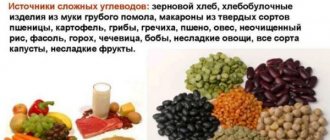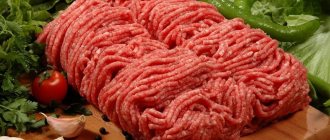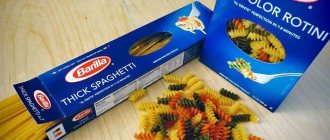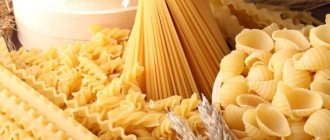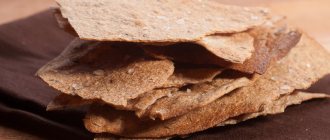What is whole grain pasta and can you lose weight on it?
Today, many nutritionists recommend that those losing weight cook whole grain pasta as a side dish.
How does this product differ from regular pasta, what does it taste like and is it possible to lose extra pounds with it? The yellowish pasta familiar to everyone is made from wheat flour. According to their characteristics, wheat varieties cultivated by agriculture are either soft or hard.
To obtain flour, the grain is crushed and then sifted through a sieve in a factory setting. The grade of the finished flour (second, first, highest) will depend on the size of the cells in the sieve. However, do not confuse the difference between the type of flour and the type of wheat. Flour obtained from durum wheat can be second grade, which means it contains impurities, as well as sifting through a larger sieve.
Most of the pasta offered on the counter is made from premium flour obtained from soft wheat. But on the Russian market there are manufacturers who follow Italian technologies and produce pasta from flour obtained from durum wheat.
From a culinary perspective, durum pasta does not become mushy when cooked, creating the pleasant sensation of a firmer-tasting product. There is a misconception that the dietary qualities of such pasta differ from products made from soft varieties. This is not true, because their calorie content is exactly the same as that of regular pasta, and is 150 kcal per 100 g.
Among the advantages, manufacturers may note such a plus of durum pasta as a lower glycemic index, but this parameter is of little importance. More important is the insulin index, which is almost the same for all pasta and has a value of about 40. This is a good indicator that says that pasta can be consumed during a diet (unless you add fatty creamy cheese sauce to it).
All this information is in publicly available sources; consumers have stopped believing previous myths about the superiority of pasta made from durum wheat, so manufacturers have taken a new step, convincing everyone of the incredible health benefits of whole grain products.
The basis was the results of a study conducted by British scientists, which showed that those who regularly consume whole grain foods have a lower risk of developing a history of cancer or heart disease. By adding marketing here, you can present a product made from waste from the flour milling industry at a cost comparable to flour from premium wheat.
When obtaining flour for making whole grain pasta, the whole grain is crushed without sifting it on a sieve, which makes it possible to enrich the flour with parts of wheat germ, a very useful shell containing the B vitamin complex, as well as iron, antioxidants, magnesium, etc.
- Calorie content – 125 kcal versus 150 kcal for regular pasta;
- Protein content – 5.8 g versus 5.3 g;
- The dietary fiber content is 2.8 g versus 1.8 g for regular pasta.
The difference turns out to be insignificant, especially if we remember the daily intake of fiber (dietary fiber) for a person. If you follow them and try to gain this indicator only by eating whole grain pasta, you will have to eat more than a kilogram of it, which is 1250 kcal.
As for group B vitamins, there are 2-5 times more of them in whole grain pasta than in regular pasta, but none of them can cover even 10% of the daily dose, so there is no need to consider the product as a serious source of these vitamins.
The magnesium content in whole grain pasta is 30 mg versus 18 mg in regular pasta, which gives 0.5-1% of the daily value. Iron in the amount of 1 mg versus 0.5 mg, which is also far from the daily requirement - only 2.5-5%. The content of vitamin E is 0.3 mg versus 0.06 mg, and a person needs 10 mg of this element per day.
The difference in the glycemic index is also small - 32 for whole grain pasta and 40 for regular pasta. This means that such pasta will not cause sudden changes in blood sugar levels in any case.
It turns out that in terms of nutritional value, whole grain pasta is not much different from regular pasta, which does not allow it to be included in the section of dietary products recommended for weight loss. In terms of taste, whole grain pasta has quite controversial reviews. Some people liked their taste, while others promise not to look in their direction anymore.
Therefore, you should not rush and buy expensive pasta, wanting to lose weight. If you follow some tips, you can keep yourself in great shape and continue to eat regular pasta, just use the following tips:
- The pasta needs to be slightly undercooked;
- It is better to eat them in the first half of the day, and not in the evening for dinner;
- For seasoning, use a light sauce rather than a heavy sauce, which is typical for an Italian restaurant;
- Pasta is combined with vegetables and mushrooms;
- It is better to choose a type of product such as thin noodles or spaghetti - they have a lower glycemic index.
preparation of the article - Anna Korobkina, nutritionist
Despite new dietary systems growing by leaps and bounds, including some that promise weight loss with pasta, there is not a single confirmed scientific fact that would allow pasta to be classified as a dietary product. In terms of taste, whole grain pasta receives equally mixed reviews - some completely abandon the usual straws in favor of “healthy” ones, while others, even when necessary, cannot bring themselves to swallow the rough product.
Pasta definitely doesn’t help burn fat, but with reasonable consumption of the product you can achieve some success in losing weight. True, this can only happen under several mandatory conditions - with a small portion of pasta eaten, and sufficient activity in the afternoon. Fiber, contained in large quantities in whole grain pasta, suppresses the feeling of hunger for a long time, creating the impression of satiety and at the same time being almost not absorbed by the body.
Pasta. How to choose the right one?
A copy of my publications on Instagram @dr.kseen . Series of 2 posts I want to talk about whole grain products, in particular about products such as PASTA . For some reason, people often make mistakes when choosing the “Durum Wheat” and “Whole Grain” labels. . It is important to understand the following: 1) Wheat comes in soft and durum varieties. The variety is like “cardinal” and “victoria” strawberries. Different varieties of wheat have different properties. Soft varieties are used for baking goodies, but they are not suitable for real pasta. Good pasta, such as spaghetti, farfalle, pene, etc., is made from durum wheat. Durum varieties have more gluten, and this significantly affects the appearance when cooked, so that there is no sticky “porridge” of pasta! . 2) Italian manufacturers make pasta from durum wheat, they are nasty, strong and do not boil into “porridge”. But at home, not for production, they prepare their famous pasta from soft varieties, since the dough from them is easier to roll out. . 3) Durum wheat varieties have better beneficial properties than soft ones; they contain much more protein, carbohydrates, and fats. But pasta labeled “whole grain” is absolutely not equal in properties to “made from durum wheat”!!! .
4) “From durum wheat” – this is a variety, nothing more, I emphasize. But processing, grinding and other manipulations with a wheat product play an important role! The same goes for rice and flour... Whole grain products are grains with shells, where all the beneficial properties are concentrated. . Continued in the next post
Part two of the series What is whole grain flour? . 1) White flour is a completely useless processed product, with the loss of all important beneficial properties of the grain.
. 2) Whole grain flour is unprocessed flour, with the shell of the grains preserved. And they contain a storehouse of vitamins, minerals, fiber, and protein. .
3) Whole grain pasta is always dark with inclusions and small particles (sometimes very small, depending on the manufacturer), because the grains were not pre-polished, but were crushed together with the shells!! . 4) Whole grain products are the “richest” in micronutrients, which means they are useful for us. Buckwheat and pearl barley, brown rice are not polished, so they are healthier. But white rice is processed and is not healthy. We harm ourselves through ignorance. We eat foods that have lost their beneficial properties, and then run to the pharmacy for vitamins and medicines... Mother Nature herself has laid the titanic power of vitamins and minerals in whole grains. Just think - there is so much benefit in 1 small grain! But, the further the progress, the more ignorant people are, unfortunately... We are fed white flour, and then they are taught that the deficiency can be filled with synthetic complexes. Therefore, it is imperative to understand nutrition issues today! . 5) In terms of cost, I didn’t notice much difference between tsz and hard varieties of pasta. Our “Makfa” also adds spinach and tomatoes to its products, you can try it for variety. But I love spinach and fresh tomatoes, so I take tsz/pasta without additives. I also eat durum varieties, but they are not my favorites. I also love buckwheat pasta, but you also need to read there, they also add wheat flour.
For recipes made from whole grain products , see the section “Delicious recipes for a great figure.”
Did you like the article? Then please do the following:
1. Like;
2. Retweet;
3. Share this article on social networks;
4. And of course, leave your comment below
Contraindications and harm of whole grain vermicelli
As soon as the talk about the benefits of durum wheat pasta died down, nutritionists around the world presented a new sensation - it turns out that the real benefits come from whole grain pasta, and not finely ground durum wheat. Is the difference between one and the other type of pasta really so significant as to warrant revising entire dietary scenarios and making such bold conclusions?
First, let's figure out whether the type of wheat, hard or soft, affects the type of flour. After all, what is flour grade? This is the level of waste contamination and the size of the dust unit (grain). The higher the degree of clogging of flour with grain shells and other impurities that reduce its quality, and the more noticeable the graininess of the finished product, the lower the grade will drop.
The wheat variety is responsible for the strength and density of the heat-treated product. For pasta, hard varieties are most preferable. This compares favorably with the taste of ready-made pasta, since they almost do not stick together after cooking and do not turn into porridge when reheated.
There are several simple rules, following which, you can extract maximum benefits even from such controversial products as whole grain pasta. The product is beneficial under the following conditions:
- Reduce the cooking time by 2-4 minutes relative to the time indicated on the package.
- Eating pasta only for breakfast or lunch.
- Refusal to use fatty gravies and sauces.
There are only two ways to harm your body by eating whole grain pasta - by excessively including it in the diet and by using fatty sauces and flavor-rich seasonings as a supplement to food.
Thick-walled pasta always has a higher glycemic index, so if you need to regulate your sugar levels, give preference to thin spaghetti.
Of course, there are significant benefits from eating whole grain pasta, but only if you do not expect a cure for all diseases from this ordinary food product. It is at least important that the composition of the products has almost no contraindications, which means it will definitely not harm anyone with allergies, asthmatics, or diabetics.
A reasonable presence of whole grain pasta in the diet can really:
- Maintain optimal blood glucose levels.
- Help reduce obesity.
- Regulate blood pressure.
- Prevent the accumulation of cholesterol plaques.
However, in all of the listed optimistic conclusions there is one significant “but” - for noticeable results and an adequate assessment of the impact of whole grain pasta on the body, it is necessary to completely exclude all types of products made from premium flour from the diet.
I think there is no such person who would not be familiar with such a popular product as pasta. There are many versions about the place of origin of this product, but people are more concerned about the benefits they bring to the body. These products are in great demand and are available in many forms that can easily be found in the store. Moreover, its pricing policy directly depends on the raw materials from which the pasta is made.
Pasta made from durum wheat is considered the healthiest. The whole secret lies in the structure of starch. In a product made from hard varieties, starch is in the form of integral crystals, which during cooking combines with protein; in cheaper varieties, the starch is structureless and is completely destroyed during cooking. Therefore, to get the benefits of eating pasta, you need to choose it only from durum wheat.
Such a product contains many vitamins, namely PP, E, A and group B. The content of potassium, calcium, magnesium, phosphorus, manganese and iron also does not lag behind in its positive effects on the body.
Today, inventive manufacturers offer us a wide selection of these products: horns, spaghetti, pasta, tubes, spirals, curls, bows and many other forms. There are even colored flour products, to the recipe of which spinach, beet or carrot juice is added to add color. Such natural dyes only increase the presence of beneficial substances.
Now you need to understand what the benefits of pasta are, what their calorie content is and how to choose and cook this product correctly.
The nutritional value of durum wheat pasta (boiled) is about 120 kcal, which is low. This is why this product is often both recommended and used during a diet for weight loss. To slightly increase the number of calories, it is useful to eat pasta with seafood, mushrooms or meat.
Vita: PP, E, A, B1, B2
rals: potassium, calcium, iron, phosphorus, sodium
Active substances: fiber, starch
Pasta made from durum wheat is beneficial for the body due to the presence of fiber. These fibers, like a sponge, are able to cleanse the gastrointestinal tract of toxins and waste, improve digestion, speed up the process of assimilation of useful substances in the form of vitamins and minerals, improve the microflora of the large intestine and normalize motility.
This product contains complex carbohydrates, which take a very long time to break down and thereby give you a feeling of fullness for 3-4 hours. Due to this property, pasta is often used for weight loss. Whole-grain varieties are especially valued; they contain much more fiber and provide many times more energy, without causing you to gain extra pounds.
Colored pasta, when added to the recipe with spinach, beet or carrot juice, increases the ral content in the composition. This product becomes even more useful. The presence of potassium and calcium has a positive effect on the structure of the muscle fibers of the heart and prevents its exhaustion. Magnesium has a beneficial effect on the general condition of the vascular system. This ral is capable of dilating blood vessels, lowering blood pressure, and preventing the development of blood stagnation and blood clots.
Durum or whole grain pasta contains vitamin B. They are responsible for the proper functioning of the central nervous system and also have a beneficial effect on neural processes in the cerebral cortex and metabolism at the cellular level.
Complex carbohydrates do not allow the glycemic level to rise beyond normal limits, so when eating this product you should not worry about the functioning of the pancreas. It can be consumed in small quantities if you have diabetes, but only pasta made from durum varieties.
Also, the ingredients contained in the product can remove cholesterol from the blood, which will help prevent the development of cholesterol plaques. Iron and magnesium have a positive effect on blood composition, increases hemoglobin levels and thereby prevents frequent headaches, oxygen starvation of all internal organs, and increases performance.
It is harmful to eat pasta if you have frequent constipation or irregular diet.
It is contraindicated to include in the diet of people with diabetes, due to the possibility of raising blood sugar (especially in cheap varieties of pasta). It is necessary to consult a doctor.
It is harmful to fill this product with a large amount of fat; this can lead to overload of the pancreas and liver. In addition, such high-calorie foods will help you gain a few extra pounds.
Briefly why they are harmful
So, what could be bad about pasta? In short:
- they are quite high in calories - 350 kilocalories per 100 grams of product;
- if you combine pasta with fatty foods (meat, cheese, mayonnaise, etc.), then they become a real calorie bomb for us, which means they harm the figure and are not at all suitable for weight loss;
- cause spikes in blood sugar levels, especially those made from refined, white flour;
- those that contain artificial colors, preservatives and other dubious ingredients are simply harmful;
- regular pasta has an oxidizing effect on our body.
However, modern scientists and even nutritionists are inclined to believe that high-quality pasta is more beneficial than harmful to human health.
They contain much-needed fiber that cleanses the body, activates the intestines, and removes toxins and waste from it.
Of course, such high-quality products contain nutrients for our body:
- tryptophan, an acid that calms and improves sleep;
- there is iron necessary for hematopoiesis, but in ordinary pasta it is 3.3 times less than in the same buckwheat;
- Vita B groups, which strengthen the immune system, improve the condition of hair and skin, have a positive effect on the nervous system, especially in whole grains;
- manganese, which normalizes brain activity, improves the condition of bones, cartilage and tissues, the same amount is found in oatmeal;
- potassium is good for the heart and the condition of blood vessels, it restores cells, improves kidney function, helps remove toxins, but even in whole grain pasta it is 8 times less than in raisins.
The same horns and others like them are an excellent source of energy and nutrition for muscles.
They fill you up quickly, are easy to prepare, and are affordable.
In moderate doses they are quite suitable even for a diet.
So, we have already found out that durum wheat pasta products are relatively safe. At the same time, those that are “soft”, with an abundance of starch, are harmful. How to distinguish one from the other? It is not difficult:
- on packs of “hard” pasta it is written “grade 1 flour”, “durum”, “durum wheat” or “group A”;
- the pasta itself is smooth, with dark dots and an even tone;
- their edge is “vitreous”;
- there are no crumbs or pieces of products in the package;
- “soft” products are covered with light dots and have a rough surface;
What is regular pasta made from?
The familiar yellowish pasta is made from wheat flour. Agriculture cultivates many varieties of wheat, and each, according to its characteristics, is classified as either hard or soft.
To obtain flour, the grain is first ground and then sifted through a sieve in a factory setting. The type of flour obtained depends on the size of the cells - premium, first and second. The difference between a wheat variety and a flour variety should not be confused. Flour can be obtained from durum wheat (“durum”), but be of the second grade - that is, with impurities, sifted through a larger sieve.
Domestic manufacturers make the lion's share of pasta from premium soft wheat flour. However, some of our companies, and almost all Italian ones (because the local law requires it) use durum wheat flour.
From a culinary point of view, pasta made from durum varieties is better because it practically does not boil over during cooking, and creates such a pleasant feeling of a harder substance in the mouth. However, contrary to popular belief, in terms of its dietary qualities, pasta made from durum wheat is no different from soft wheat and it contains exactly the same amount of calories - 150 kcal per 100 grams of the finished product.
Manufacturers often point to the dietary benefit of durum wheat pasta as a lower glycemic index, but this indicator in itself means little. The insulin index is more important, and for all pasta it is almost identical and equal to approximately 40, which is actually very, very good, and means that pasta can be allowed during a diet (of course, unless it is flavored with rich creamy cheese sauce ).
Recently, people have stopped buying into old myths about cereals, so manufacturers have come up with a new one - about the exceptional healthfulness of whole grain products.
The basis was the results of another study by “British scientists”, which showed that people who regularly eat whole grain foods have a lower risk of developing heart disease and cancer. A little marketing and voila - buy waste from the flour milling industry at the price of premium glassy wheat flour.
To obtain flour for the production of whole grain pasta, the whole grain is crushed, but not sifted through a sieve. On the one hand, this is wonderful - parts of the germ, extremely useful shells with the vitamin B complex, antioxidants, iron, magnesium, etc. get into the flour.
How to distinguish pasta made from whole flour from regular pasta?
Fortunately, this can be done by eye. Although pasta manufacturers proudly announce on the packaging that their products are correct. And the price increases noticeably, because you have to pay extra for healthy food. Pasta brands abroad, especially in Italy, are all good. Products are made from durum wheat. We'll talk about what this is below. But still, such spaghetti is made from refined rather than whole grains. If you buy pasta abroad and cannot read the labels on the packaging, take a closer look at the products themselves. Dark dots are visible on the surface of whole grain noodles - traces of the amniotic membrane.
Nutritional value of whole grain pasta
Flour for the production of whole grain pasta is obtained by chopping, rather than grinding, the grain, without first cleaning the seeds from the valuable shell. This allows you to preserve five times more group B vitamins in the bulk product than with fine grinding. However, this comparison only works with premium flour and does not stand up to any criticism when it comes to a person’s daily need for vitamins of this group.
Approximately the same can be said about other valuable elements contained in whole grain wheat pasta:
- The amount of vitamin E is 0.3 mg (in pasta made from premium flour - 0.06 mg), with a daily norm of 10 mg;
- Iron – 0.3 mg (in pasta made from premium flour – 0.06 mg), which is 5% of the daily requirement;
- Magnesium - 30 mg (in pasta made from premium flour - 18 mg), with a daily requirement of 1%.
It is easy to calculate that although the difference in the content of nutrients between whole grain pasta and regular pasta still exists, it is not so great as to clearly consider some of them harmful and others healthy. This is clearly seen from the nutritional value of both products:
- Proteins: 5.8 for whole wheat pasta and 5.3 for regular flour;
- Dietary fiber: 2.8 vs. 1.8.
- In terms of calorie content, whole grain pasta is 125 kcal versus 150 kcal for ordinary products.
Many people are scared by the calorie content of products indicated on the packaging; most often this figure ranges from 230 to 300 kcal. What does this mean and why are other indicators presented above? The fact is that whole-grain boiled pasta, the calorie content of which, however, like the most ordinary ones, is indicated taking into account the dry product, loses exactly half of the calories during cooking, and in the end we get exactly the key value of no higher than 150 kcal.
Misconceptions about pasta
Let's look at a few misconceptions about whole grain pasta:
- The insulin complex, contrary to popular belief, is practically the same for all pasta and is equal to 40, therefore for diabetic patients the type of product does not have any decisive dietary significance.
- The difference in caloric content of the compared products is also insignificant - only about 25 calories, which can be easily eliminated if you do not put butter in regular pasta.
- Reducing the risk of cancer when eating whole grain products is a controversial phenomenon. Since there is no official confirmation of this fact.
Pasta for stroke?
Here’s another interesting fact about pasta, which, of course, will still be disputed by the study, but nevertheless deserves attention. According to the results of testing in one of the American institutes, it was found that a portion of properly cooked pasta, in combination with low-fat tomato sauce and salad, helps reduce the risk of heart and vascular diseases.
The data obtained fully confirmed previous research results, which had already concluded that just 7 grams of fiber consumed per day improves the condition of blood vessels by 7%. True, as always, the advantage of such an interesting diet turns out to be insignificant against the backdrop of an incorrect lifestyle, which is specifically emphasized by scientists. Only giving up bad habits, weight control and an active lifestyle are a worthy basis for such food experiments.
Relevance
Whole grain products are considered very healthy due to their high content of dietary fiber, antioxidants and phytoactive substances.
Research results show that a diet rich in green grain products has a positive effect on reducing body weight, including fat mass, reducing insulin resistance, leading to an improvement in lipid profile and a decrease in systemic inflammation.
A new study examined the relationship between the amount of whole grains consumed and the risk of developing type 2 diabetes.
What types of whole grain pasta are there?
Whole grain pasta is no different from regular pasta in terms of variety. In addition to a variety of curly solutions, in some retail outlets - usually specializing in healthy food - you can find pasta with additives from vegetable juices, spinach, asparagus, seaweed and even cuttlefish ink.
We have written a lot about products made from wheat flour, as they are more popular and affordable, but if you seriously decide to try the whole variety of whole grain pasta products, you definitely need to find products made from spelled, corn, buckwheat, and rice flour. Most of these products can only be ordered online, but the richness and variety of flavors that you will discover are worth the effort.
What are the health benefits of whole wheat pasta?
What we are used to eating as bread and noodles is a product with a high starch content. And this component leads to obesity. Its frequent use provokes cardiovascular diseases and even, possibly, cancer. Physician Sylvester Graham was the first to point out that flour made from whole grains is not as detrimental to health as its technologically refined sister. He advised using the most natural product possible. That's why the bread base, graham flour, was named after him. And later they began to make whole grain pasta from such raw materials. Dishes made from them taste slightly different from regular spaghetti and give a feeling of pleasant firmness - al dente. And their glycemic index is lower than that of our usual noodles - thirty-two versus forty.
Spelled pasta
Spelled pasta is a special type of wheat. They are made from whole grain raw materials and are considered an excellent dietary product. Such products have a slightly darker color than usual (closer to brown), taste good and do not contain any synthetic additives. This allows you to retain all its beneficial properties for two years.
Spelled pasta retains all the beneficial properties that are characteristic of this variety of wheat, namely: high levels of fiber, low gluten content (this will reduce allergic reactions in case of intolerance to this element), sufficient presence of rales and vitae (more than in pasta from regular varieties of wheat).




